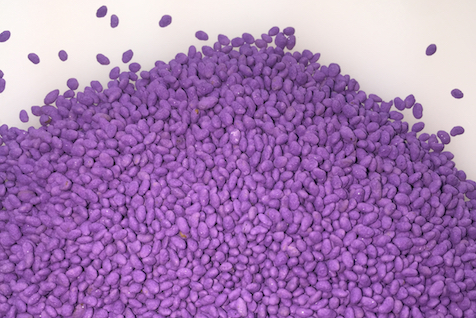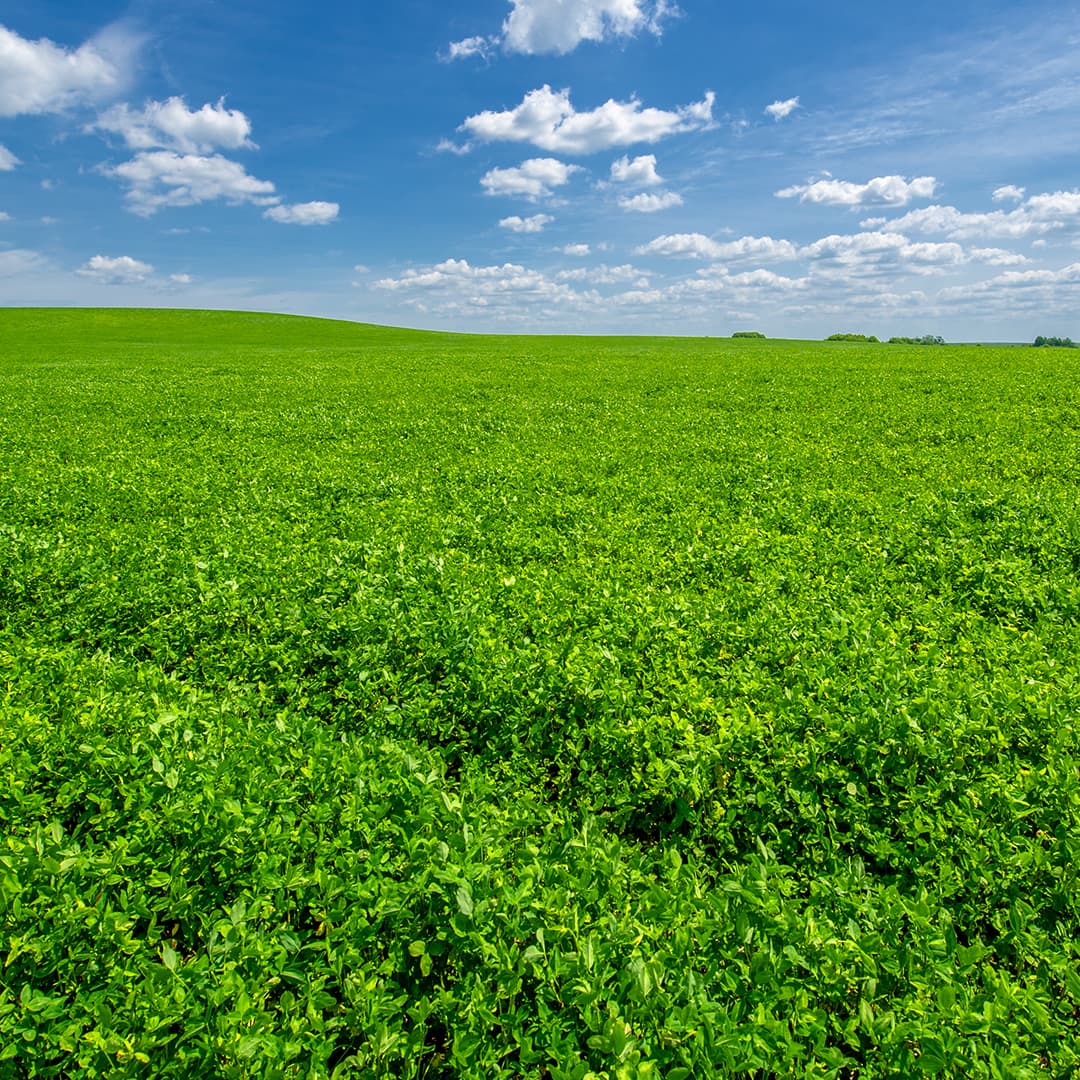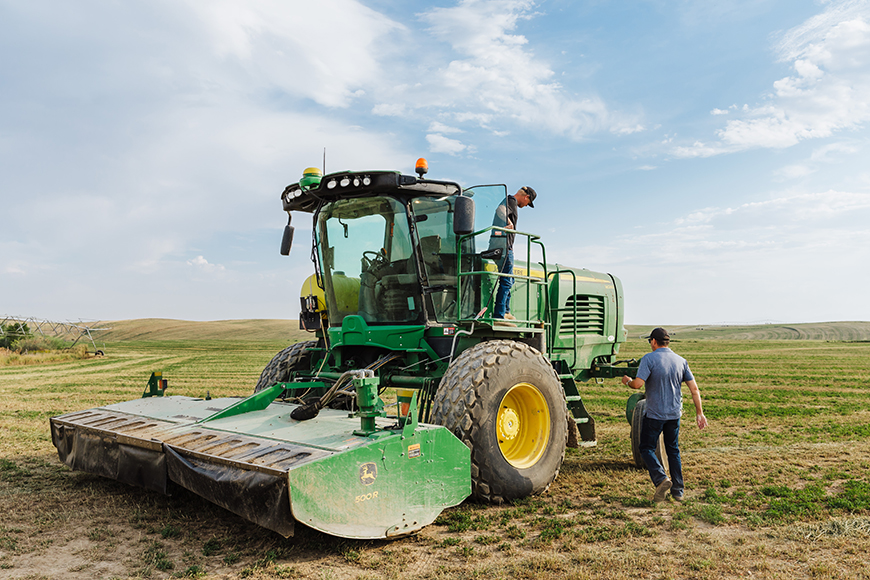While every season presents a different set of challenges for alfalfa growers, a successful crop begins with good stand establishment. Seed treatments and seed coatings are applied to most premium alfalfa seed to get plants off to a strong start, as it assists with maximizing germination and seedling survival, and help mitigate early-season threats to germination and stand establishment. Seed treatment and coating technology has improved over the years, and research shows that some of the information you may have heard about older technology isn’t relevant to today’s more sophisticated seed coatings.
Understand the Technology
Seed treatments are not the same as seed coatings; understanding the distinction is important. An alfalfa seed treatment generally consists of, at least, an inoculant with a specific strain of rhizobium bacteria for alfalfa, along with a base fungicide to manage early-season soil diseases. Alfalfa seed inoculated with rhizobium bacteria helps ensure proper nodulation so the plant is able to fix nitrogen for its growth and development. In addition to rhizobium, a base fungicide like metalaxyl (Apron®) or mefenoxam (Apron XL®) in a standard seed treatment helps protect germinating seed from early-season fungal diseases, including phytophthora and pythium. Additional fungicides like pyroclostribin (Stamina®) can also be utilized for additional seedling disease control against Aphanomyces, Rhizoctonia and Fusarium spp.
A seed coating provides more protection than a standard seed treatment. The seed coating, only consists of calcium carbonate and an inert polymer to keep nutrients and other active ingredients close to the seed to help prevent leaching during germination. Seed coatings may also add weight to small alfalfa seeds, helping improve plantability for more even emergence. A rhizobium inoculant and fungicide (similar to what is in the standard treatment), along with additional specialized components like growth promoters, micronutrients, mycorrhizae, insecticides and bioenhancers could also be added to the coating as additional treatments. A seed coating may also include hydration polymers that draw moisture to the seed to aid in germination, even in shallow, dry soil.
Bill Talley, owner of Summit Seed Coatings, says a major benefit of seed treatments and coatings is that most carry a two-year inoculant shelf life, and the rhizobium inoculant strains applied are specifically chosen and may provide better nodulation than strains that are found naturally in soil. Custom treatments can also provide a higher rate of inoculant to the seed, resulting in longer rhizobia shelf life and better nodulation. Rhizobia is a living organism that deteriorates and dies over time. With seed coatings, more inoculant can be applied to the seed and it is more evenly dispersed, providing the bacteria with more protection against heat and temperature fluctuations while seed is stored.
Insurance for Uncertain Conditions
There is hardly ever a time when a farmer has ideal conditions for plant establishment or an ideal period for seedling growth. Weather often limits planting windows, and early-season pests can inhibit germination and plant establishment. The value of a seed coating and treatment is that it helps to mitigate against these conditions at a small cost, relative to the price of the seed. This extra protection can mean the difference between a good crop and a great crop, because alfalfa that has a more vigorous start has a better chance to meet its yield potential.
Research done over the years shows a traditional seed coating can convert 50 t0 75 percent of alfalfa seeds to healthy plants. When planting uncoated or lightly coated seeds, growers can expect 20 to 40 percent to germinate into healthy plants. Talley notes that farmers will see the most benefit from a seed coating during the first 30 to 60 days after planting, when the stand is being established. He says research has shown that the number of replanted alfalfa acres also declines when a seed coating is added.
Fact or Fiction?
Because there are a lot of claims out there about seed treatments and seed coatings, it’s hard to know what’s fact and what’s fiction. One myth that farmers often hear is that they will have to plant more seeds per acre to compensate for the inert matter included in a bag of coated alfalfa seed. This misconception stems from a focus on pure live seed (PLS) that was utilized more than 20 years ago. Talley says today’s seed coatings help maximize the number of healthy plants established from each pound of seed, so farmers are able to plant the same rate of coated alfalfa seed as they would of raw, uncoated seed. Germination rates and stand establishment for coated and treated seed are higher than for raw seed, so you don’t need as many alfalfa seeds per acre to get the same stand results.
Growers may be familiar with old seed coating technology that left a dusty residue in the seed bag and on planting equipment. Talley says today’s seed coatings are more advanced. The new formulations actually improve movement through the planter and are cleaner to use than traditional seed treatments. He recommends that farmers recalibrate their planting equipment when they switch to coated seed because there can be a 5 to 10 percent increase in seed flow due to a slicker seed coat.
Benefits of a Heavy Seed Coating
You may wonder what the terms “light” and “heavy” refer to when seed brands talk about their seed coatings. Light alfalfa coatings contain 8 to 9 percent inert matter (coating material), compared to heavy coatings that are closer to 34 percent inert matter. A light coating can help reduce dust that is common with a raw seed treatment with inoculant and fungicide. Light coatings also help inoculant stick to the seed better than using a standard seed treatment without coating.
The benefit of a heavy coating is that it adds hydroscopic properties to the seed, attracting moisture for better germination, even in shallow, dry soils. As mentioned, heavy coatings serve as a carrier for adding other products like micronutrients and bioenhancers to the treatment to further protect the seed and assist with enhanced germination and stand establishment. There are claims that light coatings are a better alternative than heavy coatings for stand establishment, since more alfalfa seeds per pound are planted in this scenario. However, light-coated seeds have a lower germination rate compared to heavy-coated seeds, so this claim is invalid. You’ll actually see better stand establishment with fewer heavy-coated seeds because they are more likely to develop into healthy plants.
Looking to the Future
Seed coating technology continues to evolve and will certainly offer more options to growers in the coming years. As formulations advance, be sure to stay informed so that you understand the benefits and limitations of the treatments and coatings that protect your alfalfa seeds. Your local agronomist or seed agent can help you establish proper planting rates based on your seed choice and agronomic conditions.
Apron is a registered trademark of Ciba-Geigy. Apron XL is a registered trademark of a Syngenta Group Company. Stamina is a registered trademark of BASF.
Understand the Technology
Seed treatments are not the same as seed coatings; understanding the distinction is important. An alfalfa seed treatment generally consists of, at least, an inoculant with a specific strain of rhizobium bacteria for alfalfa, along with a base fungicide to manage early-season soil diseases. Alfalfa seed inoculated with rhizobium bacteria helps ensure proper nodulation so the plant is able to fix nitrogen for its growth and development. In addition to rhizobium, a base fungicide like metalaxyl (Apron®) or mefenoxam (Apron XL®) in a standard seed treatment helps protect germinating seed from early-season fungal diseases, including phytophthora and pythium. Additional fungicides like pyroclostribin (Stamina®) can also be utilized for additional seedling disease control against Aphanomyces, Rhizoctonia and Fusarium spp.
A seed coating provides more protection than a standard seed treatment. The seed coating, only consists of calcium carbonate and an inert polymer to keep nutrients and other active ingredients close to the seed to help prevent leaching during germination. Seed coatings may also add weight to small alfalfa seeds, helping improve plantability for more even emergence. A rhizobium inoculant and fungicide (similar to what is in the standard treatment), along with additional specialized components like growth promoters, micronutrients, mycorrhizae, insecticides and bioenhancers could also be added to the coating as additional treatments. A seed coating may also include hydration polymers that draw moisture to the seed to aid in germination, even in shallow, dry soil.
Bill Talley, owner of Summit Seed Coatings, says a major benefit of seed treatments and coatings is that most carry a two-year inoculant shelf life, and the rhizobium inoculant strains applied are specifically chosen and may provide better nodulation than strains that are found naturally in soil. Custom treatments can also provide a higher rate of inoculant to the seed, resulting in longer rhizobia shelf life and better nodulation. Rhizobia is a living organism that deteriorates and dies over time. With seed coatings, more inoculant can be applied to the seed and it is more evenly dispersed, providing the bacteria with more protection against heat and temperature fluctuations while seed is stored.
Insurance for Uncertain Conditions
There is hardly ever a time when a farmer has ideal conditions for plant establishment or an ideal period for seedling growth. Weather often limits planting windows, and early-season pests can inhibit germination and plant establishment. The value of a seed coating and treatment is that it helps to mitigate against these conditions at a small cost, relative to the price of the seed. This extra protection can mean the difference between a good crop and a great crop, because alfalfa that has a more vigorous start has a better chance to meet its yield potential.
Research done over the years shows a traditional seed coating can convert 50 t0 75 percent of alfalfa seeds to healthy plants. When planting uncoated or lightly coated seeds, growers can expect 20 to 40 percent to germinate into healthy plants. Talley notes that farmers will see the most benefit from a seed coating during the first 30 to 60 days after planting, when the stand is being established. He says research has shown that the number of replanted alfalfa acres also declines when a seed coating is added.
Fact or Fiction?
Because there are a lot of claims out there about seed treatments and seed coatings, it’s hard to know what’s fact and what’s fiction. One myth that farmers often hear is that they will have to plant more seeds per acre to compensate for the inert matter included in a bag of coated alfalfa seed. This misconception stems from a focus on pure live seed (PLS) that was utilized more than 20 years ago. Talley says today’s seed coatings help maximize the number of healthy plants established from each pound of seed, so farmers are able to plant the same rate of coated alfalfa seed as they would of raw, uncoated seed. Germination rates and stand establishment for coated and treated seed are higher than for raw seed, so you don’t need as many alfalfa seeds per acre to get the same stand results.
Growers may be familiar with old seed coating technology that left a dusty residue in the seed bag and on planting equipment. Talley says today’s seed coatings are more advanced. The new formulations actually improve movement through the planter and are cleaner to use than traditional seed treatments. He recommends that farmers recalibrate their planting equipment when they switch to coated seed because there can be a 5 to 10 percent increase in seed flow due to a slicker seed coat.
Benefits of a Heavy Seed Coating
You may wonder what the terms “light” and “heavy” refer to when seed brands talk about their seed coatings. Light alfalfa coatings contain 8 to 9 percent inert matter (coating material), compared to heavy coatings that are closer to 34 percent inert matter. A light coating can help reduce dust that is common with a raw seed treatment with inoculant and fungicide. Light coatings also help inoculant stick to the seed better than using a standard seed treatment without coating.
The benefit of a heavy coating is that it adds hydroscopic properties to the seed, attracting moisture for better germination, even in shallow, dry soils. As mentioned, heavy coatings serve as a carrier for adding other products like micronutrients and bioenhancers to the treatment to further protect the seed and assist with enhanced germination and stand establishment. There are claims that light coatings are a better alternative than heavy coatings for stand establishment, since more alfalfa seeds per pound are planted in this scenario. However, light-coated seeds have a lower germination rate compared to heavy-coated seeds, so this claim is invalid. You’ll actually see better stand establishment with fewer heavy-coated seeds because they are more likely to develop into healthy plants.
Looking to the Future
Seed coating technology continues to evolve and will certainly offer more options to growers in the coming years. As formulations advance, be sure to stay informed so that you understand the benefits and limitations of the treatments and coatings that protect your alfalfa seeds. Your local agronomist or seed agent can help you establish proper planting rates based on your seed choice and agronomic conditions.
Apron is a registered trademark of Ciba-Geigy. Apron XL is a registered trademark of a Syngenta Group Company. Stamina is a registered trademark of BASF.



